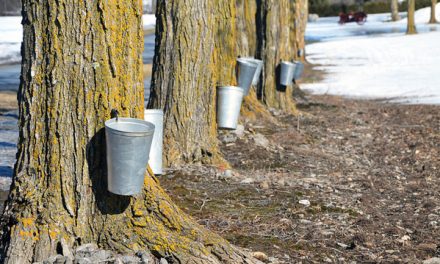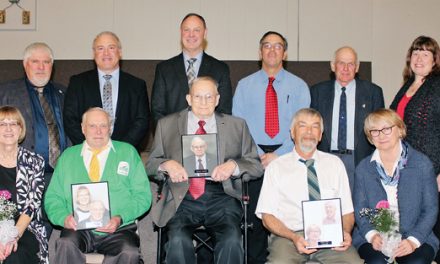by Kalynn Sawyer Helmer
AgriNews Staff Writer
SDG – In 2014 aerial photographs from eastern Ontario were studied by the South Nation Conservation Authority and revealed that the forest cover in the jurisdiction had dropped under the recommended 30 per cent to 28 per cent. In 2017 an Agricultural Forest Cover Committee was assembled by SNC to meet over the course of five months and present the SNC board with recommendations to mitigate the issue on the agricultural side. Agriculture was one of the leading factors for forest cover loss including, industrial and commercial developments, residential land developments, solar farms and unsustainable forest harvesting.
Most recently on July 12, Alison McDonald, manager of planning at the SDG Counties, presented County Council with a report to promote preserving and enhancing forest cover in SDG. “We are trending [downward] and if it keeps on that trend where we are losing one million trees a year, it will get to a point where we don’t have enough to sustain clean air, clean water, mitigate soil erosion, etc. That is what prompted us to look at the issue as a county,” McDonald said. “The county is looking at practical solutions that we can do to help. That is why we went to council to give them everything we had heard about that we think is practical, fair, reasonable and doable financially or legislatively.”
McDonald said the County Council was very receptive of the recommendations and ideas, giving the go ahead to look into each with more depth to flesh out the best options going forward. McDonald said the next steps are to put together a team to do just that and then present the ideas to the incoming council after the election. To get there, one step McDonald wants to take is presenting to and getting insight from the local federations of agriculture. “In the presentation to council we focused on areas that the Agricultural Forest Cover Committee supported in their recommendations and also tailored them into what the county can do,” she said. McDonald was involved in the Agricultural Forest Cover Committee and said the time showcased that many use best management practices but that there are also those who do their business differently. “They came together as a group and said they were also concerned with the issue but worried that they were being negatively portrayed as an industry and they wanted a two pronged approach. One that showcases agriculture but also does something about the people that aren’t necessarily a showcase for the community,” said McDonald.
During the council meeting where McDonald gave the presentation, North Dundas Mayor Eric Duncan suggested low or no taxes for forested land as an incentive. McDonald agreed that the idea was viable – being that forested land is not using services, but that, to move forward there must be conversations with the treasurer and financial departments. What McDonald said she would like to know from the federations of agriculture, is whether such incentives would be enough to keep class four or five land, forested, versus clearing.
Another incentive idea is to change the Eco-gift program. McDonald explained that during the sale of a farm, which would involve large capital gains, succession planning, severing land for children and RSPs, that these are not enough to offset those capital gains, so to help farmers can make an Eco-gift. “If we can get Eco-gift programs going that value forested land at the value it would be as farmland, then you might be able to sever off 100 acres and donate that to the county or the conservation authority and potentially generate around $1.5-million in revenue offset for the sale of your property. At the time of liquidating or selling off the farm, you also make an Eco-gift transfer for the value of the forest as farmland and then you get a taxable benefit that is spread over multiple years. That’s a very practical, tangible, win-win situation that we are looking for.”
The forest cover issue brings forward a lot of different opinions and some of those involved look to other counties in Ontario. But McDonald explained, “If you’ve gone to southwestern Ontario and seen some of the farmland there, where there is about four per cent forest cover, they have irrigation issues, crop and soil erosion issues, but their farmland is second to none. Somewhere like Lanark or Frontenac is all trees because they are on the shield they don’t have great farmland. SDG is totally different than both of those extremes. We have a lot of excellent farmland and then we have swampy, rocky mineral areas, which you can do farming on like goats, hops and beef, but you don’t necessarily have to clear cut 100 acres of a swamp and then try to do cropping and large livestock. We have a balance between those two types of landscapes and that makes it really difficult.”
When looking at the numbers, it can be overwhelming to see so much loss and many in the agricultural community have felt the backlash from conservation advocates. McDonald, however, said she is hesitant to come down too hard on agriculture. “For the most part, [farmers] may be doing exactly what they should be doing which is clearing good farm land that should be farmed,” she said. “The issue is, do we know where we are clearing, do we understand as an agricultural community what the best practices would be, do we understand leaving a buffer up to a watercourse and how that might benefit the agricultural land?”
One of the major problems however, comes when industrial land clearing is happening without adherence to best practices. The only way to truly stop such needless clear-cutting is with a by-law or regulation. This creates fear for many in the agricultural community since the regulation might start out just trying to control industrial clearing and end up with a broader scope. “Once it’s there, who’s to say it won’t be expanded,” said McDonald.
For McDonald as well as many others who come from the rural areas of SDG, forested land plays a big part in the quality rural life that the area and its residents are trying to preserve. Big block forests throughout farmland and rural SDG means good habitats, flood and drought mitigation, reduced soil erosion and the preservation of clean air and clean water. In order to maintain the quality rural lifestyle of the area, McDonald advocates for a perfect balance – crops on the right classes of soil, wetlands and forests that remain on less viable farming land. “If you drive around a lot, around the whole county, you start to think that the balance is moving too far in the wrong direction,” said McDonald. “If everyone cares about this, lets all do our part. Everybody has a part to play and everybody has to agree this is important.”
Anyone with ideas or comments is encouraged to contact McDonald at
amcdonald@sdgcounties.ca.












